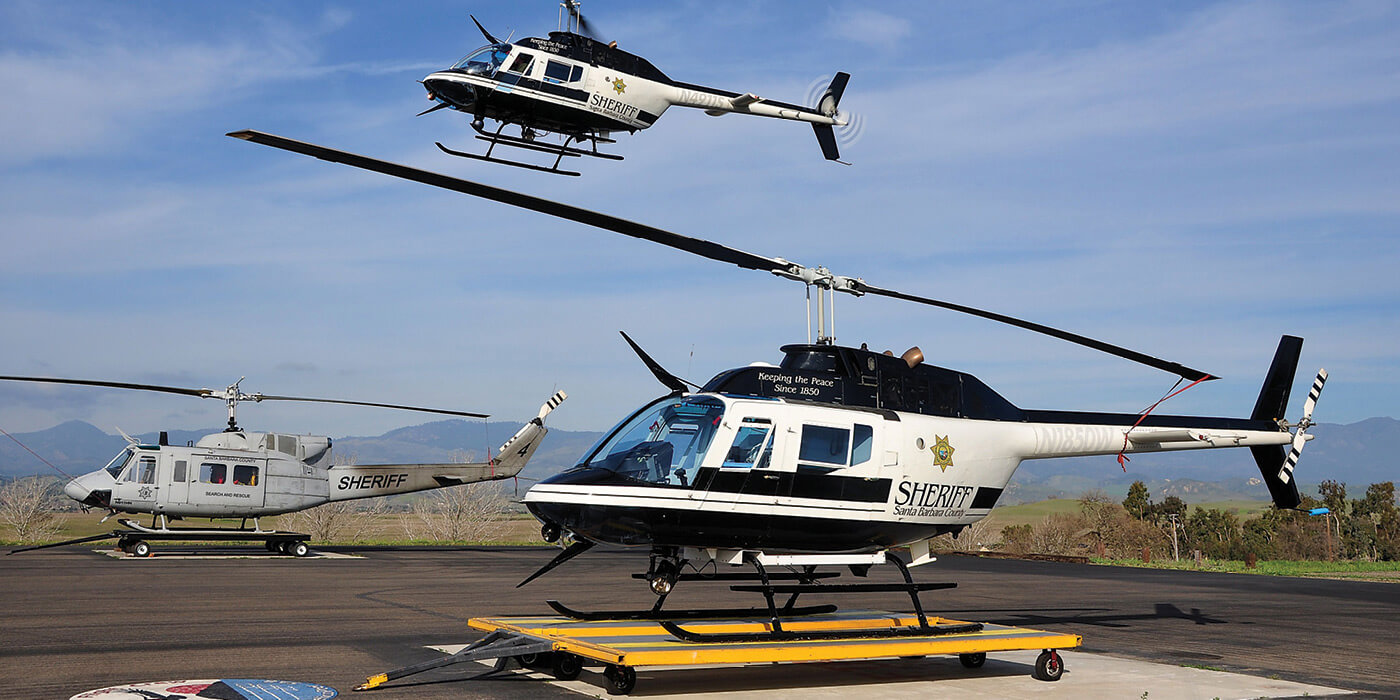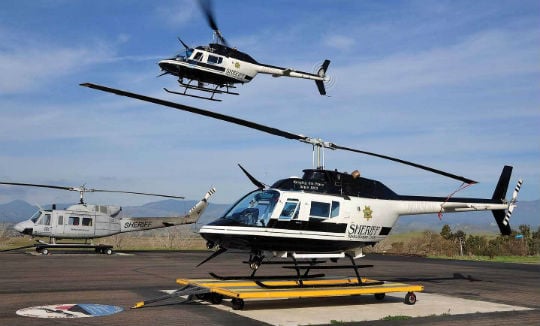
The separation of the civilian and military sectors is a hallowed tradition in free countries. Only in a police state is a cop’s job supposed to be easy.
But in recent years, there has been growing unease among civil libertarians and politicians about the militarization of civilian police forces in the United States, which is supposed to be the world’s leading democracy. In post-9/11 America, the line between soldier and cop has blurred.
This nettlesome issue came to the fore during the violent protests in the St. Louis, Mo., suburb of Ferguson, after Michael Brown — an unarmed black 18-year-old — was shot and killed by a police officer there in August 2014. The suburb’s population is mostly black, while its political leadership and police force are mostly white.
In the turbulent weeks that followed, hundreds of people flooded the streets to protest Brown’s death, provoking a militarized response from police that awakened Americans to the extent of surplus Pentagon hardware that’s in the hands of local cops.
The ensuing social unrest spread to other cities and sparked a fierce public debate over a two-decade-old Pentagon program called “1033,” which provides surplus military equipment to state and local police.
In addition to rifles, grenade launchers, armored personnel carriers and other military gear, the 1033 program annually gives civilian cops millions of dollars’ worth of surplus military helicopters. The program is run by the Defense Logistics Agency, which is in charge of getting and disbursing supplies of all types for the military.
Not surprisingly, the consensus within the airborne law enforcement community is that surplus military helicopters operated by police departments further the common good. These helicopters, police leaders argue, save the lives of citizens as well as officers. However, we heard from civil libertarians and helicopter police commanders who also voiced a few caveats. Below, we examine both sides of the issue.
1033 under the microscope
The U.S. Department of Defense (DoD) 1033 program allows the transfer, without charge, of excess DoD property to law enforcement agencies (LEAs). Equipment, vehicles and helicopters valued at about $5.4 billion have been distributed since 1033 began in 1997.
As of 2015, roughly 8,000 local law enforcement agencies have participated in the program; material worth $449 million was transferred in 2013 alone. The most commonly obtained item from the 1033 program is “general equipment” (which may include such items as office furniture and computers); the most common type of aircraft by far is rotorcraft. Since 2006, 1033 has distributed 616 aircraft, most of them helicopters.
Criticism of the program is bipartisan and not new. Notably, in 2003, the Office of the Inspector General within the U.S. Department of Defense issued a report on 1033 that pinpointed fraud, waste and abuse. But it wasn’t until Ferguson that nationwide attention was focused on the program. The American Civil Liberties Union (ACLU) captured many of the concerns surrounding 1033 in a 2014 report titled War Comes Home: The Excessive Militarization of American Policing, which argues that 1033 is helping turn police departments into paramilitary forces.
Noting that nearly 80 percent of the SWAT raids it studied were conducted to serve search warrants, usually in drug cases, the ACLU press office stated, “With public support for the War on Drugs at an all-time low, police are using hyper-aggressive, wartime tools and tactics to fight a war that has lost its public mandate.”
Tom Scarlett, a Washington, D.C.-based lawyer and journalist active in civil liberties, noted: “Much of this Pentagon surplus equipment is overkill and only serves to intimidate the local population. It creates fear in neighborhoods and a pervading sense of ‘Big Brother is watching.’”
Even as police departments became increasingly militarized, the Federal Bureau of Investigation reported that violent crime in the U.S. was close to a 40-year low.
In the wake of Ferguson, lawmakers began to echo some of the ACLU’s concerns. U.S. Sen. Dick Durbin (D-Illinois) asked the Defense Department to evaluate 1033, with an eye towards possibly canceling the program. Durbin stated that he wanted to make sure the program “is carried out with the safeguards, accountability and oversight that our communities need and deserve.”
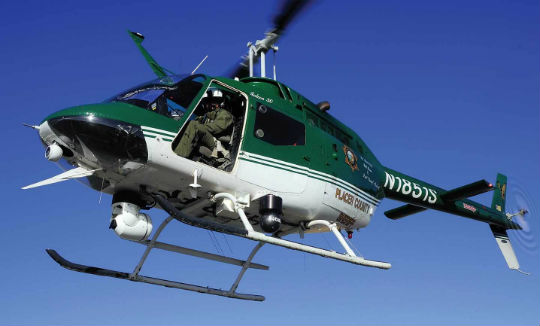
U.S. Senator Rand Paul (R-KY), a conservative who is a candidate in the 2016 presidential race, stated that the federal government “has incentivized the militarization of local police precincts and helped municipal governments build what are essentially small armies.”
Spurred by Ferguson, two Congressional committees — the House Armed Services Committee and the Senate Committee on Homeland Security and Governmental Affairs — called hearings on the 1033 program.
In January 2015, President Obama issued Executive Order 13688, which established an interagency Law Enforcement Equipment Working Group “to identify interagency actions that can improve federal support for the acquisition of controlled equipment by LEAs.”
Through those actions, the order sought to provide LEAs with “controlled equipment that is appropriate to the needs of their community,” and ensure that “LEAs are properly trained to employ the controlled equipment they acquire.” The order also wanted to make sure that LEAs “adopt organizational and operational practices and standards that prevent the misuse or abuse of controlled equipment, and that they comply with civil rights requirements resulting from receipt of federal financial assistance.”
In May 2015, that Law Enforcement Working Group provided a report containing its recommendations pursuant to Executive Order 13688. The report established a list of “prohibited” equipment that should not be authorized for LEAs to acquire via transfer from federal agencies or purchase using federally provided funds. The list included “weaponized aircraft, vessels and vehicles of any kind,” as well as tracked armored vehicles, firearms and ammunition of .50-caliber or higher, grenade launchers, bayonets and certain camouflage uniforms.
Additionally, the report created a “controlled equipment list” including equipment that “has significant utility for state, local or tribal law enforcement operations.” Fixed- and rotary-wing manned aircraft and unmanned aerial vehicles (UAVs) are included on this list, which LEAs may continue to acquire through federal programs.
However, “because of the lethal nature of the equipment and/or the potential negative impact on the community, LEAs are required to take additional steps to acquire this equipment, including the submission of a detailed justification outlining their need for procuring the equipment and certification that agency controls . . . are in place to prevent misuse of the equipment.”
The report noted that aircraft and command and control vehicles are included on the controlled equipment list “because they require special licenses to operate or their sheer size can have an undesired intimidating effect on the general public if used inappropriately or indiscriminately.”
Notably, the report identifies only fixed- and rotary-wing aircraft and command and control vehicles as “suitable for sale or transfer to the general public as long as any sensitive or law enforcement components and insignias are removed,” since such vehicles are “essentially airplanes, helicopters and recreational vehicles (RVs) that can serve everyday commercial and private capacities.”
That’s in contrast to other types of controlled equipment, including explosives, firearms and UAVs, which “present potentially substantial risks if possessed and used by civilians.”
In October 2015, the Department of Justice provided an update on the process of implementing the working group’s recommendations, which took effect at the beginning of fiscal year 2016. Key implementation steps included the formation of a Permanent Federal Interagency Law Enforcement Working Group to support oversight and policy development functions for controlled equipment programs, and “engagement with relevant stakeholders through multiple meetings and the receipt of written comments to obtain feedback on implementation approaches.”
Most controversially, the Department of Defense began recalling equipment on the prohibited equipment list, including tracked armored vehicles, grenade launchers and bayonets. This prompted complaints from some lawmakers and from the National Sheriffs’ Association (NSA), who have pointed to a high-profile mass shooting in San Bernardino, Calif., on Dec. 2, 2015, as evidence that LEAs should continue to have access to items on the prohibited list.
However, attorney Tom Scarlett echoed the sentiments of civil libertarians when he said, “Grenade launchers and bayonets have no place in a local police force.”
But beyond tighter control of bayonets and grenades, did much really change? Not really, says the airborne law enforcement community.
Dan Schwarzbach, executive director and CEO of the Maryland-based Airborne Law Enforcement Association, gave his group’s take on Executive Order 13688 and its ramifications so far.
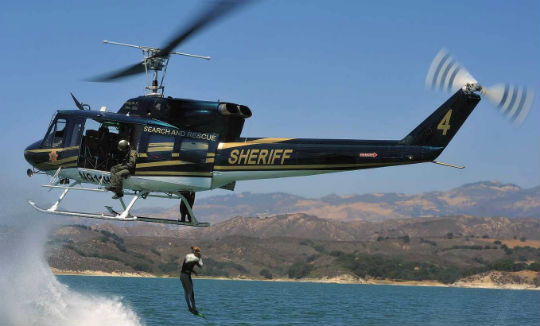
“Our view is that the aircraft that are being released to us are what’s called ‘controlled equipment’ anyway, with required training and the like,” Schwarzbach said. “So if you sift through the verbiage, the result is that we haven’t really seen any tangible operational changes. The changes really apply to other militarized, non-aircraft gear.”
Capt. Don Roby, formerly of the Baltimore County Police Department, echoed Schwarzbach’s assertion that Executive Order 13688 doesn’t substantially alter the picture for airborne police. “There’s less there than meets the eye for us,” he said.
Roby retired from the Baltimore County Police Department in December 2015. He formerly was head of the Baltimore County Police Department’s aviation unit and now serves as chair of the International Association of Chiefs of Police Aviation Committee. “13688 mostly cracked down on armored personnel carriers and weapons,” Roby said. “And we expected that to happen, after Ferguson and Baltimore.”
Military Helos: Help or hindrance?
Should small-town cops get their hands on M-16s, grenade launchers and mine-resistant vehicles? That question is not within the purview of this article; our focus here is on helicopters.
Although weaponized aircraft are on the prohibited list that resulted from Executive Order 13688, the DoD isn’t confiscating any Apache attack helicopters as a result, because such aircraft were never distributed to LEAs in the first place.
As a National Public Radio analysis of Defense Logistics Agency records notes, “of the aircraft listed in the data, none was specifically listed as having weapons. Ninety-seven percent of helicopters were listed as utility, observation, trainer, medevac or search-and-rescue — the other three percent were simply listed as ‘aircraft, rotary-wing.’”
Dan Schwarzbach said that U.S. police departments are predominantly receiving either OH-58 Kiowas or military versions of the Bell 206, with a smattering of UH-60 Black Hawks, UH-1 Hueys and OH-6 Cayuses. Many of the aircraft are Vietnam War vintage.
“These surplus aircraft are mostly used as surveillance and observation platforms,” Schwarzbach said. “That’s what most of them were originally designed for.”
In fact, the military surplus helicopters being acquired by law enforcement agencies through the 1033 program are often significantly less capable than modern, high-performance aircraft acquired on the commercial market, which many LEAs prefer for surveillance and SWAT support. Consequently, military surplus helicopters may have only marginal bearing on the issues of greatest concern to the ACLU and other civil libertarians.
This correspondent spoke with high-ranking and influential airborne police leaders about whether the helicopter aspect of 1033 is a public benefit or menace — and they weren’t shy in defending the program.
“These concerns about civil liberties are completely overblown,” said Captain Kurt Frisz, St. Louis County Police Department. Frisz has considerable credibility on the issue; he was the man in charge of all SWAT operations and air support during the Ferguson upheavals.
“There’s always been some angst with the 1033 program, but now civil libertarians are using Ferguson as the poster child for their concerns,” Frisz said. “Here’s what they conveniently forget, though — there was only one surplus military helicopter used during the Ferguson riots, an OH-6 for surveillance.”
Frisz also pointed out that the armored personnel carriers and other equipment that people saw on television didn’t even come from 1033. “We bought them retail, directly from the OEMs, and they’re expressly created for civilian police department use. What’s more, they’re defensive and not offensive,” he said.
Schwarzbach underscored Frisz’s point that military surplus helicopters are for defensive purposes. In addition to his leadership duties at the ALEA, Schwarzbach serves as a helicopter pilot with the Houston Police Department and has 3,800 hours of helicopter flying time under his belt.
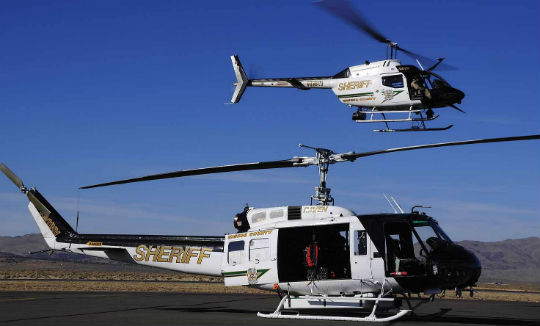
“In terms of 1033, we certainly support local and state law enforcement being able to access this equipment,” he said. “Taxpayers have already paid for it and it helps our mission, without having to spend taxpayer money all over again for those items. It’s a great way to give law enforcement the tactical advantage of aviation.”
Not such a great deal?
There’s also the concern that “free” is not really free, after all. Case in point: The Newark Police Department in 2005 received two 40-year-old Vietnam-era OH-58A Bell Kiowa helicopters from the Pentagon, one to fly and one for spare parts. Problem is, the cash-strapped city spent more than $2 million to refurbish and repair the aging Kiowa. The helicopter came under critical local and national press scrutiny in 2015 and at last report the aging aircraft was rarely being used.
Schwarzbach countered that the cost-benefit analysis with surplus military helicopters is a nuanced one.
“These aircraft come from the military and they’re pretty green in terms of tactical equipment,” he said. “They need to be equipped, with spotlights, moving maps, thermal imaging, what have you, and those things don’t come cheap. Any police force that wants surplus military equipment should know what they’re getting into. But if you have to buy the equipment anyway and the airframe is free, it’s economical.”
He said homework on the front end is crucial. “We get a lot of inquiries from police departments that want to start an aviation program and they ask us: ‘What sort of aircraft should we buy?’ Well, it starts with the mission. Tailor the aircraft to the mission; don’t just run out and procure aircraft and then try to figure out what to do with it.”
Capt. Don Roby reiterated the same line of reasoning. “1033 allows an agency to acquire an aircraft with no out of pocket expense,” Roby said. “But that doesn’t mean it’s a free aircraft; it has to be refurbished, equipped and maintained.”
Roby said these surplus helicopters are effective at responding to calls, surveillance, searches, search-and-rescue, crime and crash scene photography, fire service work, pursuit management and situational awareness. “Very few police departments use these surplus military helicopters to project lethal force,” he asserted.
Roby also pointed out that 1033 is a broad program that includes more than just helicopters — and the allowed use of these aircraft is not unfettered.
“When you talk about 1033, you’re talking about a host of equipment, from armored personnel carriers to M-16s to NVGs, but when it comes to the aircraft, they’re audited every year by the federal government and we have to account for every flight hour,” he said. “There’s a lot of good that comes out of 1033; it saves cops lives. It’s not mostly lethal force encounter stuff. The helicopter aspect should be controlled and none of us have a problem with that.”
Roby added that disposal of the helicopters is carefully regulated. “The government doesn’t want these aircraft to go to foreign countries, nor do they want agencies to reap the benefits for a couple of years and then sell them,” he said. “We have to account for these aircraft and keep records as to their use and whereabouts; our use of them is not unrestricted.”
Roby said surplus military aircraft also launch fledging aviation units. “In Baltimore, we started with free aircraft and then when we developed experience we branched out and purchased other more sophisticated models,” he said. “We first learned to crawl, then walk, then run. Our aviation unit wouldn’t have been possible without first starting with surplus military aircraft.”
Roby noted a recent event that he views as unfortunate. Effective Dec. 31, 2015, the liaison between the Pentagon and airborne law enforcement was eliminated due to federal government cutbacks.
“Historically, this person has been from the law enforcement community and they could explain our needs to the DoD, and that position was critical for us, and now it’s gone,” Roby said. “This is a troublesome development, because we don’t have a voice representing us anymore concerning the peacetime use of this equipment. That could hurt us, because the liaison always gave us a heads-up as to what was available. Now, equipment we might have gotten in the past might just be destroyed.”
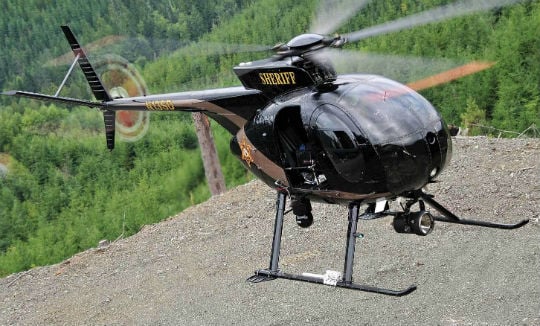
Taking responsibility
James DiGiovanna, chief executive officer of the Public Safety Aviation Accreditation Commission, an affiliate of the ALEA, is a retired helicopter pilot/captain with the Los Angeles County Sheriff’s Department. He served as commander of the department’s Aero Bureau for 17 years and he’s also a retired U.S. Army Aviator Colonel.
With these impeccable credentials, DiGiovanna is considered the “go to” guy for any agency or person who seeks to better understand 1033 as it relates to helicopters.
Not surprisingly, DiGiovanna strongly asserted that 1033 is a boon for law enforcement — and for the public.
“The 1033 program has enabled many agencies to acquire aircraft when most likely they would not have been able to,” he said. “It’s been a great opportunity to expand the capabilities of many law enforcement agencies.”
DiGiovanna bristled at the notion that police misuse these helicopters to terrorize the populace. “Aircraft aren’t issued to agencies for dubious reasons; they’re released to protect and serve people,” he said.
DiGiovanna conceded, however, that one critical point is well taken: Some police agencies aren’t sufficiently trained to operate these aircraft.
He noted that legislation is now pending in Congress to mandate training and certification for police to use these aircraft. As part of this legislation’s mandate, his public safety committee would provide standards that any police agency must first comply with to qualify for 1033 helicopters. However, as of this writing, this proposed bill is languishing in committee.
“This bill, HR 139, isn’t going anywhere and besides, 13688 makes it a moot point,” Schwarzbach said.
That said, one limitation of 13688, DiGiovanna asserted, is that it doesn’t require verification that the police agency has conducted the necessary training. “HR 139 would implement federal review and verification, and that’s a higher standard of safety,” he said. He said that he’s now working to get HR 139 reintroduced in the next Congress.
Capt. Frisz asserted “I’m a big fan” of the idea of imposing greater training and certification before aircraft are awarded to an agency. “Agencies should be held accountable,” he said. “The 1033 program should continue, but it should continue responsibly. The airborne law enforcement community needs to stand up and insist that police agencies get the right training before they receive these helicopters.”
DiGiovanna added that police agencies must go into the 1033 program with their eyes wide open and conduct due diligence, to realize what the costs are to train personnel and operate and maintain these aircraft.
“It’s the responsibility of the police agency to make sure that it can afford this free equipment,” he said. “With proper planning and execution, agencies can go into this program with a good understanding of what they’re getting into and they can create budgets accordingly.”
Frisz said he knows of police departments that got in over their heads with 1033 aircraft. “I’ve seen examples of agencies that think, ‘Oh, cool, free aircraft,’ but then after crashes or hard landings they discover that they can’t afford the helicopters. Police should start with the mission and then get the appropriate equipment, not the other way around.”





